The 2005 Ferrari 430, a masterpiece of Italian engineering, arrived on the scene as a potent blend of power, elegance, and cutting-edge technology. This mid-engined sports car, a successor to the legendary 360 Modena, quickly cemented its place as a modern icon, captivating enthusiasts with its exhilarating performance and timeless design.
Its arrival marked a significant moment in Ferrari’s history, ushering in a new era of supercar innovation that continues to inspire today.
The 430 was more than just a performance machine; it was a statement of luxury and refinement. Its sculpted exterior, characterized by sharp lines and flowing curves, exuded an air of sophistication, while its meticulously crafted interior offered a sanctuary of comfort and exclusivity.
Underneath its sleek exterior, the 430 housed a potent 4.3-liter V8 engine, capable of unleashing a symphony of power and a thrilling driving experience. The 430’s impact on the automotive world was undeniable, leaving a lasting legacy that continues to inspire both car enthusiasts and designers alike.
Overview
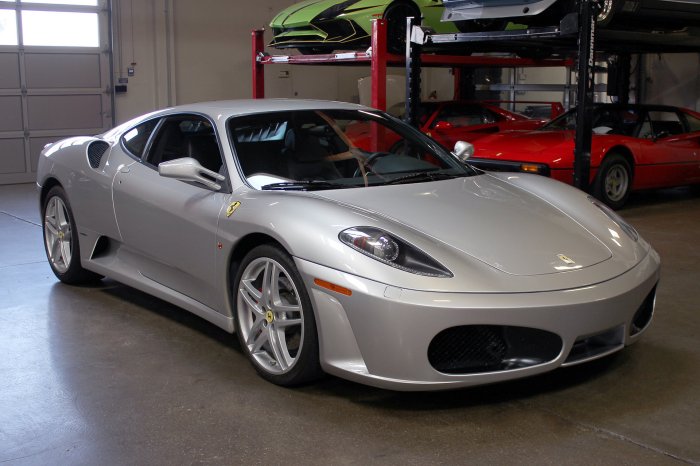
The 2005 Ferrari 430, a mid-engine sports car, marked a significant milestone in the Italian marque’s history. It replaced the iconic Ferrari 360 Modena, introducing a new era of performance, design, and technological advancements. The 430 solidified Ferrari’s position as a leader in the supercar segment, captivating enthusiasts worldwide with its exhilarating driving experience and timeless elegance.
Place in the Ferrari Lineup
The 430 occupied a prominent position within Ferrari’s model range, representing the entry point into the world of Ferrari ownership. It offered a blend of accessibility and performance, catering to a wide range of drivers. The 430 was positioned below the more powerful and exclusive Ferrari 599 GTB Fiorano, creating a distinct hierarchy within the brand’s lineup.
Design and Styling: 2005 Ferrari 430
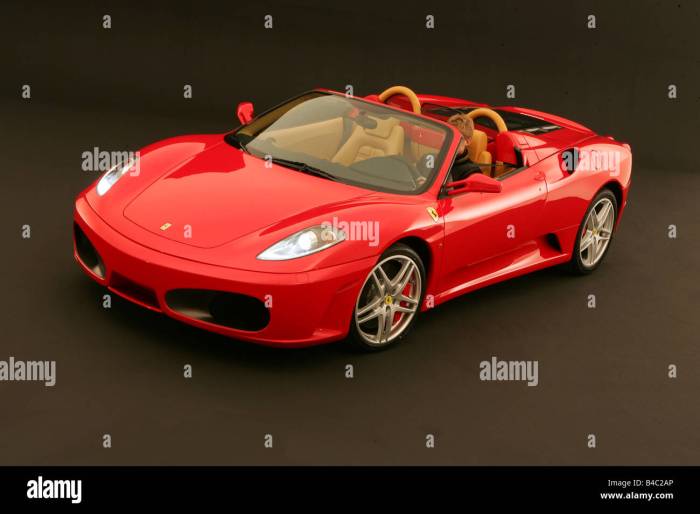
The Ferrari 430 is a testament to the Italian automaker’s commitment to both performance and aesthetics. Its design is a captivating blend of aggressive lines, elegant curves, and aerodynamic efficiency, making it a true icon of automotive design.
The 2005 Ferrari 430, with its sleek lines and powerful V8 engine, marked a new era for the Italian marque. While the 430 represented a modern approach to performance and design, it was built upon the legacy of earlier Ferraris like the 1976 Ferrari 365BB , a classic that helped establish Ferrari’s reputation for exquisite craftsmanship and unparalleled driving experience.
The 430, though a technological marvel, still retained that quintessential Ferrari spirit, a spirit that was forged in the fires of earlier models like the 365BB.
Exterior Design
The 430’s exterior design is characterized by its sharp angles, sculpted surfaces, and dramatic lines. Its low-slung profile, combined with its wide track and prominent wheel arches, exudes an undeniable sense of power and athleticism. The front fascia features a large, aggressive grille with a prominent Ferrari shield, flanked by narrow headlights that give the car a piercing gaze.
- The car’s sculpted hood flows seamlessly into the windshield, creating a sleek and aerodynamic profile.
- The rear end is equally striking, with a prominent diffuser and quad exhaust tips that further enhance the car’s aggressive stance.
- The 430’s design incorporates several aerodynamic features, such as a rear spoiler and a flat underbody, to improve downforce and stability at high speeds.
Interior Design
The interior of the Ferrari 430 is a symphony of luxury and performance. It’s a driver-focused cockpit that offers a blend of comfort, functionality, and exclusivity. The dashboard is designed with a driver-centric layout, with all the essential controls within easy reach.
- The seats are upholstered in high-quality leather and offer excellent support and comfort, even during spirited driving.
- The steering wheel is wrapped in leather and features a variety of controls, including paddle shifters for the F1 gearbox.
- The center console is home to the infotainment system, climate controls, and other essential functions.
Material Quality
The Ferrari 430 is a testament to the use of premium materials. The interior is adorned with high-quality leather, carbon fiber, and aluminum, all carefully chosen for their durability, aesthetics, and tactile appeal.
The 2005 Ferrari 430, with its sleek lines and powerful V8 engine, is a modern masterpiece. However, its lineage can be traced back to the iconic 1985 Ferrari 308 GTS , a car that defined the era of mid-engined sports cars.
While the 430 boasts advanced technology and increased performance, it still carries the essence of the 308 GTS, reminding us of Ferrari’s enduring legacy of passion and engineering excellence.
- The leather upholstery is supple and comfortable, with meticulous stitching and attention to detail.
- The carbon fiber accents, such as the dashboard trim and the center console, add a touch of sportiness and lightness to the interior.
- The aluminum accents, such as the gear shifter and the pedals, provide a sense of solidity and refinement.
Performance and Handling
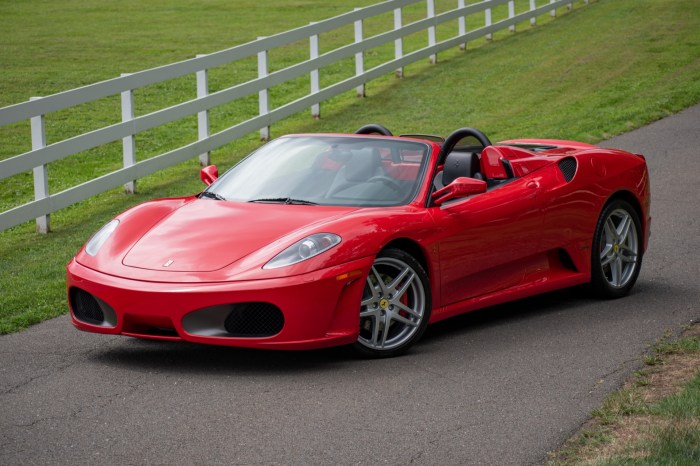
The Ferrari 430 is renowned for its exceptional performance and handling, making it a true driver’s car. The car’s powerful engine, advanced transmission, and meticulously engineered chassis contribute to an exhilarating driving experience.
Engine Specifications
The 430 is powered by a 4.3-liter naturally aspirated V8 engine, a masterpiece of Ferrari engineering. This engine produces an impressive 483 horsepower at 8,000 rpm and 343 lb-ft of torque at 5,250 rpm. The engine’s high revving nature and smooth power delivery contribute to the 430’s thrilling performance.
Transmission
The 430 is equipped with a 6-speed F1-style automated manual transmission, which allows for lightning-fast gear changes. This transmission features paddle shifters mounted on the steering wheel, providing drivers with precise control over gear selection. The transmission’s responsiveness and quick shift times enhance the 430’s acceleration and overall performance.
The 2005 Ferrari 430, a successor to the 360 Modena, showcased a more refined and powerful approach to the mid-engine sports car formula. Its design, however, harked back to the elegance of earlier Ferraris like the 1978 Ferrari 400 GT , a grand tourer that epitomized classic Italian design and performance.
The 430, with its sharp lines and powerful engine, brought a modern twist to this legacy, becoming a sought-after collectible in its own right.
Handling and Driving Dynamics
The Ferrari 430’s handling is a testament to its meticulous engineering. The car features a lightweight aluminum chassis and a sophisticated suspension system, designed to provide precise handling and exceptional grip. The 430’s low center of gravity and balanced weight distribution contribute to its exceptional cornering abilities.
The car’s responsive steering and powerful brakes allow drivers to confidently navigate even the most challenging corners.
Technological Advancements
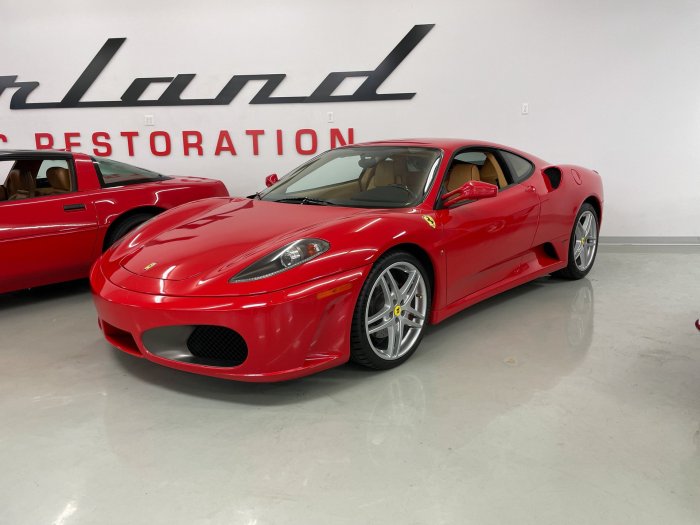
The 2005 Ferrari 430 was a technological marvel, incorporating several innovative features that enhanced performance, comfort, and driver engagement. These advancements built upon the legacy of its predecessors and set a new standard for supercars of its time.
F1-Derived Technology
The 430 was heavily influenced by Ferrari’s Formula One racing program, integrating numerous technologies developed on the track. This included the use of a "Manettino" system, a rotary dial on the steering wheel that allowed drivers to adjust the car’s electronic stability control (ESC), traction control (TC), and suspension settings.
This system provided a level of driver customization previously unseen in production cars.
- The 430’s F1-derived gearbox was a revolutionary system that utilized paddle shifters mounted on the steering wheel for quick and precise gear changes. This technology, borrowed directly from Ferrari’s Formula One cars, eliminated the need for a traditional clutch pedal, enhancing both performance and driver engagement.
- The 430 also featured a sophisticated traction control system that used sensors to detect wheel slip and adjust engine power and brake pressure to maintain optimal grip. This technology, honed on the racetrack, provided greater control and stability, particularly during aggressive acceleration and cornering.
Advanced Electronics and Driver Aids, 2005 Ferrari 430
The 430’s advanced electronics played a crucial role in enhancing both performance and driver comfort. The car’s engine management system, for example, employed a sophisticated array of sensors to optimize fuel injection, ignition timing, and other engine parameters, resulting in increased power output and fuel efficiency.
- The 430’s electronic stability control (ESC) system was designed to intervene when the car approached the limits of its handling capabilities, helping to prevent loss of control. This system, while subtle in its operation, provided an extra layer of safety, particularly for inexperienced drivers.
- The car’s suspension system, incorporating electronically controlled dampers, offered a balance between comfort and handling. The system adjusted damping force based on road conditions and driver input, providing a smooth ride on rough roads while maintaining sharp handling on the track.
Comparison to Predecessors and Contemporaries
The 2005 Ferrari 430 represented a significant leap forward in terms of technology compared to its predecessors, such as the 360 Modena. The 430’s F1-derived gearbox, advanced electronics, and enhanced driver aids set it apart from its contemporaries. For example, the Lamborghini Gallardo, a direct competitor, lacked the sophistication of the 430’s F1-derived gearbox and advanced traction control system.
Historical Context
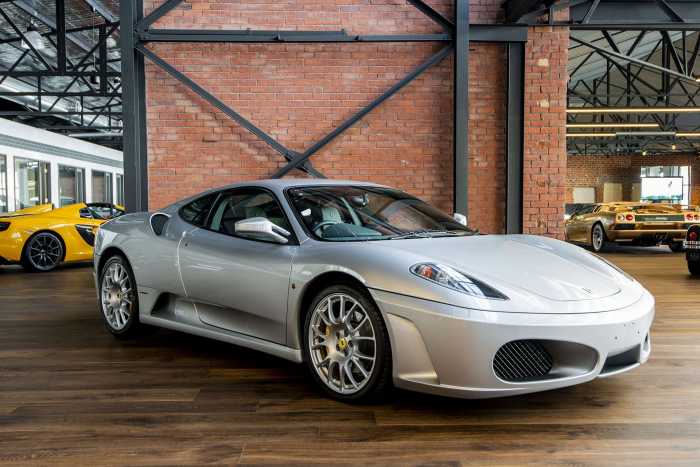
The Ferrari 430 emerged during a period of intense innovation and competition in the supercar segment. The early 2000s witnessed a surge in performance, technology, and design, pushing the boundaries of what was possible in automotive engineering.
The Supercar Landscape of 2005
The supercar market in 2005 was characterized by a fierce rivalry between established brands like Ferrari, Lamborghini, and Porsche, each striving to deliver the most exhilarating driving experience. These manufacturers were constantly pushing the limits of performance, introducing advanced technologies, and refining their designs to capture the attention of discerning enthusiasts.
- Ferrariwas already a legend, known for its racing heritage and iconic design. The 360 Modena, the predecessor to the 430, had been a commercial success, setting the stage for the 430’s arrival.
- Lamborghinihad also experienced a resurgence in popularity with models like the Murciélago, known for its aggressive styling and powerful V12 engine.
- Porsche, renowned for its engineering excellence, was making waves with the Carrera GT, a track-focused supercar with a naturally aspirated V10 engine.
Comparison to Competitors
The Ferrari 430 was positioned as a direct competitor to the Lamborghini Gallardo and the Porsche 911 GT3. It shared a similar price point and performance envelope, offering a compelling blend of luxury, performance, and exclusivity.
- The Lamborghini Gallardowas known for its raw power and aggressive styling, appealing to drivers seeking a more visceral driving experience.
- The Porsche 911 GT3was celebrated for its handling prowess and track-oriented focus, attracting drivers who prioritized precision and control.
- The Ferrari 430, however, aimed to strike a balance between these two extremes, offering a more refined and luxurious driving experience while still delivering exceptional performance.
Cultural Impact of the Ferrari 430
The Ferrari 430 became a cultural icon, embodying the aspirational lifestyle associated with the Ferrari brand. It was featured in numerous films, television shows, and video games, further solidifying its status as a symbol of luxury, performance, and exclusivity. Its sleek design and powerful engine captivated the imagination of car enthusiasts worldwide, making it one of the most desirable supercars of its era.
“The Ferrari 430 was more than just a car; it was a statement, a symbol of success and achievement.”
Legacy and Impact

The Ferrari 430, with its sleek design, powerful performance, and technological advancements, left an indelible mark on the automotive world and cemented its place in Ferrari’s legacy. Its impact extends beyond its initial success, influencing subsequent models and continuing to captivate enthusiasts.
Influence on Subsequent Ferrari Models
The Ferrari 430’s success laid the groundwork for future Ferrari models, influencing design, performance, and technological advancements. Its lightweight aluminum chassis, for example, set a new standard for Ferrari construction, paving the way for future models like the 458 Italia and the 488 GTE.
The 430’s innovative F1-derived technologies, such as the E-Diff electronic differential and the Manettino system, were further developed and refined in subsequent models, enhancing their performance and handling.
Enduring Appeal
The Ferrari 430’s enduring appeal stems from its perfect blend of performance, style, and technology. Its timeless design, characterized by its flowing lines and aggressive curves, continues to turn heads. Its powerful V8 engine, capable of delivering exhilarating acceleration and a symphony of sound, remains a highlight for enthusiasts.
The 430’s innovative features, such as the Manettino system and the E-Diff, provide a level of control and performance that is still admired today.
Closing Summary
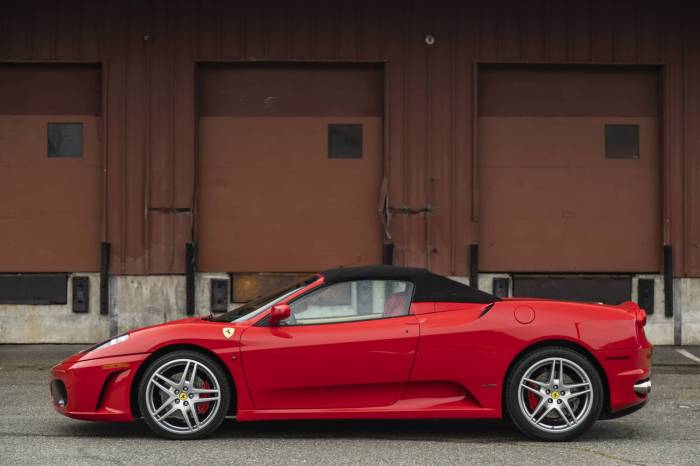
The 2005 Ferrari 430 stands as a testament to Ferrari’s unwavering commitment to pushing the boundaries of performance and design. Its influence is still felt today, as subsequent Ferrari models continue to draw inspiration from its iconic lines and innovative technologies.
The 430 remains a coveted collectible, a symbol of automotive excellence and a timeless reminder of the enduring allure of the Prancing Horse.